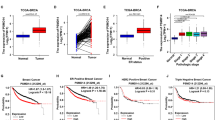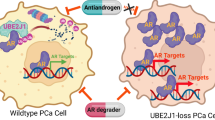Abstract
Proteolysis targeting chimeric molecules (Protacs) target proteins for destruction by exploiting the ubiquitin-dependent proteolytic system of eukaryotic cells. We designed two Protacs that contain the peptide ‘degron’ from hypoxia-inducible factor-1α, which binds to the Von –Hippel–Lindau (VHL) E3 ubiquitin ligase complex, linked to either dihydroxytestosterone that targets the androgen receptor (AR; Protac-A), or linked to estradiol (E2) that targets the estrogen receptor-α (ERα; Protac-B). We hypothesized that these Protacs would recruit hormone receptors to the VHL E3 ligase complex, resulting in the degradation of receptors, and decreased proliferation of hormone-dependent cell lines. Treatment of estrogen-dependent breast cancer cells with Protac-B induced the degradation of ERα in a proteasome-dependent manner. Protac-B inhibited the proliferation of ERα-dependent breast cancer cells by inducing G1 arrest, inhibition of retinoblastoma phosphorylation and decreasing expression of cyclin D1, progesterone receptors A and B. Protac-B treatment did not affect the proliferation of estrogen-independent breast cancer cells that lacked ERα expression. Similarly, Protac-A treatment of androgen-dependent prostate cancer cells induced G1 arrest but did not affect cells that do not express AR. Our results suggest that Protacs specifically inhibit the proliferation of hormone-dependent breast and prostate cancer cells through degradation of the ERα and AR, respectively.
This is a preview of subscription content, access via your institution
Access options
Subscribe to this journal
Receive 50 print issues and online access
$259.00 per year
only $5.18 per issue
Buy this article
- Purchase on Springer Link
- Instant access to full article PDF
Prices may be subject to local taxes which are calculated during checkout






Similar content being viewed by others
References
Alarid ET, Preisler-Mashek MT, Solodin NM . (2003). Thyroid hormone is an inhibitor of estrogen-induced degradation of estrogen receptor-alpha protein: estrogen-dependent proteolysis is not essential for receptor transactivation function in the pituitary. Endocrinology 144: 3469–3476.
Bakin RE, Gioeli D, Sikes RA, Bissonette EA, Weber MJ . (2003). Constitutive activation of the Ras/mitogen-activated protein kinase signaling pathway promotes androgen hypersensitivity in LNCaP prostate cancer cells. Cancer Res 63: 1981–1989.
Bargagna-Mohan P, Baek SH, Lee H, Kim K, Mohan R . (2005). Use of PROTACS as molecular probes of angiogenesis. Bioorg Med Chem Lett 15: 2724–2727.
Blundell TL . (1996). Structure-based drug design. Nature 384: 23–26.
Borras M, Laios I, el Khissiin A, Seo HS, Lempereur F, Legros N et al. (1996). Estrogenic and antiestrogenic regulation of the half-life of covalently labeled estrogen receptor in MCF-7 breast cancer cells. J Steroid Biochem Mol Biol 57: 203–213.
Broach JR, Thorner J . (1996). High-throughput screening for drug discovery. Nature 384: 14–16.
Bubendorf L, Kononen J, Koivisto P, Schraml P, Moch H, Gasser TC et al. (1999). Survey of gene amplifications during prostate cancer progression by high-throughout fluorescence in situ hybridization on tissue microarrays. Cancer Res 59: 803–806.
Butt AJ, McNeil CM, Musgrove EA, Sutherland RL . (2005). Downstream targets of growth factor and oestrogen signalling and endocrine resistance: the potential roles of c-Myc, cyclin D1 and cyclin E. Endocr Relat Cancer 12 (Suppl 1): S47–S59.
Buzdar AU . (2003). Advances in endocrine treatments for postmenopausal women with metastatic and early breast cancer. Oncologist 8: 335–341.
Clarke R, Skaar T, Leonessa F, Brankin B, James M, Brunner N et al. (1996). Acquisition of an antiestrogen-resistant phenotype in breast cancer: role of cellular and molecular mechanisms. Cancer Treat Res 87: 263–283.
Craft N, Shostak Y, Carey M, Sawyers CL . (1999). A mechanism for hormone-independent prostate cancer through modulation of androgen receptor signaling by the HER-2/neu tyrosine kinase. Nat Med 5: 280–285.
Culig Z, Hobisch A, Cronauer MV, Radmayr C, Trapman J, Hittmair A et al. (1994). Androgen receptor activation in prostatic tumor cell lines by insulin-like growth factor-I, keratinocyte growth factor, and epidermal growth factor. Cancer Res 54: 5474–5478.
Culig Z, Hoffmann J, Erdel M, Eder IE, Hobisch A, Hittmair A et al. (1999). Switch from antagonist to agonist of the androgen receptor bicalutamide is associated with prostate tumour progression in a new model system. Br J Cancer 81: 242–251.
Culig Z, Klocker H, Bartsch G, Steiner H, Hobisch A . (2003). Androgen receptors in prostate cancer. J Urol 170: 1363–1369.
Dauvois S, Danielian PS, White R, Parker MG . (1992). Antiestrogen ICI 164384 reduces cellular estrogen receptor content by increasing its turnover. Proc Natl Acad Sci USA 89: 4037–4041.
Doisneau-Sixou SF, Sergio CM, Carroll JS, Hui R, Musgrove EA, Sutherland RL . (2003). Estrogen and antiestrogen regulation of cell cycle progression in breast cancer cells. Endocr Relat Cancer 10: 179–186.
Duong V, Boulle N, Daujat S, Chauvet J, Bonnet S, Neel H et al. (2007). Differential regulation of estrogen receptor alpha turnover and transactivation by Mdm2 and stress-inducing agents. Cancer Res 67: 5513–5521.
Eder IE, Hoffmann J, Rogatsch H, Schafer G, Zopf D, Bartsch G et al. (2002). Inhibition of LNCaP prostate tumor growth in vivo by an antisense oligonucleotide directed against the human androgen receptor. Cancer Gene Ther 9: 117–125.
Ellis MJ, Coop A, Singh B, Mauriac L, Llombert-Cussac A, Janicke F et al. (2001). Letrozole is more effective neoadjuvant endocrine therapy than tamoxifen for ErbB-1- and/or ErbB-2-positive, estrogen receptor-positive primary breast cancer: evidence from a phase III randomized trial. J Clin Oncol 19: 3808–3816.
Fan M, Nakshatri H, Nephew KP . (2004). Inhibiting proteasomal proteolysis sustains estrogen receptor-alpha activation. Mol Endocrinol 18: 2603–2615.
Franco OE, Onishi T, Yamakawa K, Arima K, Yanagawa M, Sugimura Y et al. (2003). Mitogen-activated protein kinase pathway is involved in androgen-independent PSA gene expression in LNCaP cells. Prostate 56: 319–325.
Gaddipati JP, McLeod DG, Heidenberg HB, Sesterhenn IA, Finger MJ, Moul JW et al. (1994). Frequent detection of codon 877 mutation in the androgen receptor gene in advanced prostate cancers. Cancer Res 54: 2861–2864.
Godoy-Tundidor S, Hobisch A, Pfeil K, Bartsch G, Culig Z . (2002). Acquisition of agonistic properties of nonsteroidal antiandrogens after treatment with oncostatin M in prostate cancer cells. Clin Cancer Res 8: 2356–2361.
Hogan Jr JC . (1996). Directed combinatorial chemistry. Nature 384: 17–19.
Huggins C . (1967). Endocrine-induced regression of cancers. Cancer Res 27: 1925–1930.
Karin M, Ben-Neriah Y . (2000). Phosphorylation meets ubiquitination: the control of NF-[kappa]B activity. Annu Rev Immunol 18: 621–663.
Kim WY, Kaelin WG . (2004). Role of VHL gene mutation in human cancer. J Clin Oncol 22: 4991–5004.
Kirschberg TA, VanDeusen CL, Rothbard JB, Yang M, Wender PA . (2003). Arginine-based molecular transporters: the synthesis and chemical evaluation of releasable taxol-transporter conjugates. Org Lett 5: 3459–3462.
Klein-Hitpass L, Ryffel GU, Heitlinger E, Cato AC . (1988). A 13 bp palindrome is a functional estrogen responsive element and interacts specifically with estrogen receptor. Nucleic Acids Res 16: 647–663.
Knudsen KE, Arden KC, Cavenee WK . (1998). Multiple G1 regulatory elements control the androgen-dependent proliferation of prostatic carcinoma cells. J Biol Chem 273: 20213–20222.
Liao X, Tang S, Thrasher JB, Griebling TL, Li B . (2005). Small-interfering RNA-induced androgen receptor silencing leads to apoptotic cell death in prostate cancer. Mol Cancer Ther 4: 505–515.
Linja MJ, Savinainen KJ, Saramaki OR, Tammela TL, Vessella RL, Visakorpi T . (2001). Amplification and overexpression of androgen receptor gene in hormone-refractory prostate cancer. Cancer Res 61: 3550–3555.
Lonard DM, Nawaz Z, Smith CL, O'Malley BW . (2000). The 26S proteasome is required for estrogen receptor-alpha and coactivator turnover and for efficient estrogen receptor-alpha transactivation. Mol Cell 5: 939–948.
Moul JW . (2000). Prostate specific antigen only progression of prostate cancer. J Urol 163: 1632–1642.
Parkin DM, Bray F, Ferlay J, Pisani P . (2005). Global cancer statistics, 2002. CA Cancer J Clin 55: 74–108.
Pink JJ, Jordan VC . (1996). Models of estrogen receptor regulation by estrogens and antiestrogens in breast cancer cell lines. Cancer Res 56: 2321–2330.
Preisler-Mashek MT, Solodin N, Stark BL, Tyriver MK, Alarid ET . (2002). Ligand-specific regulation of proteasome-mediated proteolysis of estrogen receptor-alpha. Am J Physiol Endocrinol Metab 282: E891–E898.
Rau KM, Kang HY, Cha TL, Miller SA, Hung MC . (2005). The mechanisms and managements of hormone-therapy resistance in breast and prostate cancers. Endocr Relat Cancer 12: 511–532.
Reid G, Hubner MR, Metivier R, Brand H, Denger S, Manu D et al. (2003). Cyclic, proteasome-mediated turnover of unliganded and liganded ERalpha on responsive promoters is an integral feature of estrogen signaling. Mol Cell 11: 695–707.
Sakamoto KM, Kim KB, Kumagai A, Mercurio F, Crews CM, Deshaies RJ . (2001). Protacs: chimeric molecules that target proteins to the Skp1-Cullin-F box complex for ubiquitination and degradation. Proc Natl Acad Sci USA 98: 8554–8559.
Sakamoto KM, Kim KB, Verma R, Ransick A, Stein B, Crews CM et al. (2003). Development of Protacs to target cancer-promoting proteins for ubiquitination and degradation. Mol Cell Proteomics 2: 1350–1358.
Santen RJ . (1992). Clinical review 37: endocrine treatment of prostate cancer. J Clin Endocrinol Metab 75: 685–689.
Savarese DM, Halabi S, Hars V, Akerley WL, Taplin ME, Godley PA et al. (2001). Phase II study of docetaxel, estramustine, and low-dose hydrocortisone in men with hormone-refractory prostate cancer: a final report of CALGB 9780. Cancer and Leukemia Group B. J Clin Oncol 19: 2509–2516.
Savouret JF, Bailly A, Misrahi M, Rauch C, Redeuilh G, Chauchereau A et al. (1991). Characterization of the hormone responsive element involved in the regulation of the progesterone receptor gene. EMBO J 10: 1875–1883.
Schneekloth Jr JS, Fonseca FN, Koldobskiy M, Mandal A, Deshaies R, Sakamoto K et al. (2004). Chemical genetic control of protein levels: selective in vivo targeted degradation. J Am Chem Soc 126: 3748–3754.
Taplin ME, Bubley GJ, Ko YJ, Small EJ, Upton M, Rajeshkumar B et al. (1999). Selection for androgen receptor mutations in prostate cancers treated with androgen antagonist. Cancer Res 59: 2511–2515.
Thiele B, Weidemann W, Schnabel D, Romalo G, Schweikert HU, Spindler KD . (1999). Complete androgen insensitivity caused by a new frameshift deletion of two base pairs in exon 1 of the human androgen receptor gene. J Clin Endocrinol Metab 84: 1751–1753.
Ueda T, Bruchovsky N, Sadar MD . (2002). Activation of the androgen receptor N-terminal domain by interleukin-6 via MAPK and STAT3 signal transduction pathways. J Biol Chem 277: 7076–7085.
Verdine GL . (1996). The combinatorial chemistry of nature. Nature 384: 11–13.
Wijayaratne AL, McDonnell DP . (2001). The human estrogen receptor-alpha is a ubiquitinated protein whose stability is affected differentially by agonists, antagonists, and selective estrogen receptor modulators. J Biol Chem 276: 35684–35692.
Zegarra-Moro OL, Schmidt LJ, Huang H, Tindall DJ . (2002). Disruption of androgen receptor function inhibits proliferation of androgen-refractory prostate cancer cells. Cancer Res 62: 1008–1013.
Acknowledgements
We thank Tammy Phung for her kind assistance in the flow cytometry performance in the UCLA Jonsson Comprehensive Cancer Center and Center for AIDS Research Flow Core Facility that is supported by the national Institutes of Health awards CA-16042 and AI-28697, by the Jonsson Cancer Center, the UCLA AIDS Institute and the David Geffen School of Medicine at UCLA. This work was supported by NIH R21 CA108545 (KMS), Department of Defense (USA) Prostate Cancer Research Program W81XWH-06-1-0192 (AR), Postdoctoral fellowship Ministerio de Educacion y Ciencia (Spain) MEC/Fulbright EX 2005-0517 (AR) and NIH R21 R21 CA118631 (CMC). RJD is an Investigator of the Howard Hughes Medical Institute.
Author information
Authors and Affiliations
Corresponding author
Additional information
Supplementary Information accompanies the paper on the Oncogene website (http://www.nature.com/onc)
Supplementary information
Rights and permissions
About this article
Cite this article
Rodriguez-Gonzalez, A., Cyrus, K., Salcius, M. et al. Targeting steroid hormone receptors for ubiquitination and degradation in breast and prostate cancer. Oncogene 27, 7201–7211 (2008). https://doi.org/10.1038/onc.2008.320
Received:
Revised:
Accepted:
Published:
Issue Date:
DOI: https://doi.org/10.1038/onc.2008.320
Keywords
This article is cited by
-
Proteolysis-targeting chimeras (PROTACs) in cancer therapy
Molecular Cancer (2022)
-
PROTAC: targeted drug strategy. Principles and limitations
Russian Chemical Bulletin (2022)
-
Predicting the structural basis of targeted protein degradation by integrating molecular dynamics simulations with structural mass spectrometry
Nature Communications (2022)
-
ARVib suppresses growth of advanced prostate cancer via inhibition of androgen receptor signaling
Oncogene (2021)
-
Androgen receptor variant-driven prostate cancer II: advances in laboratory investigations
Prostate Cancer and Prostatic Diseases (2020)



